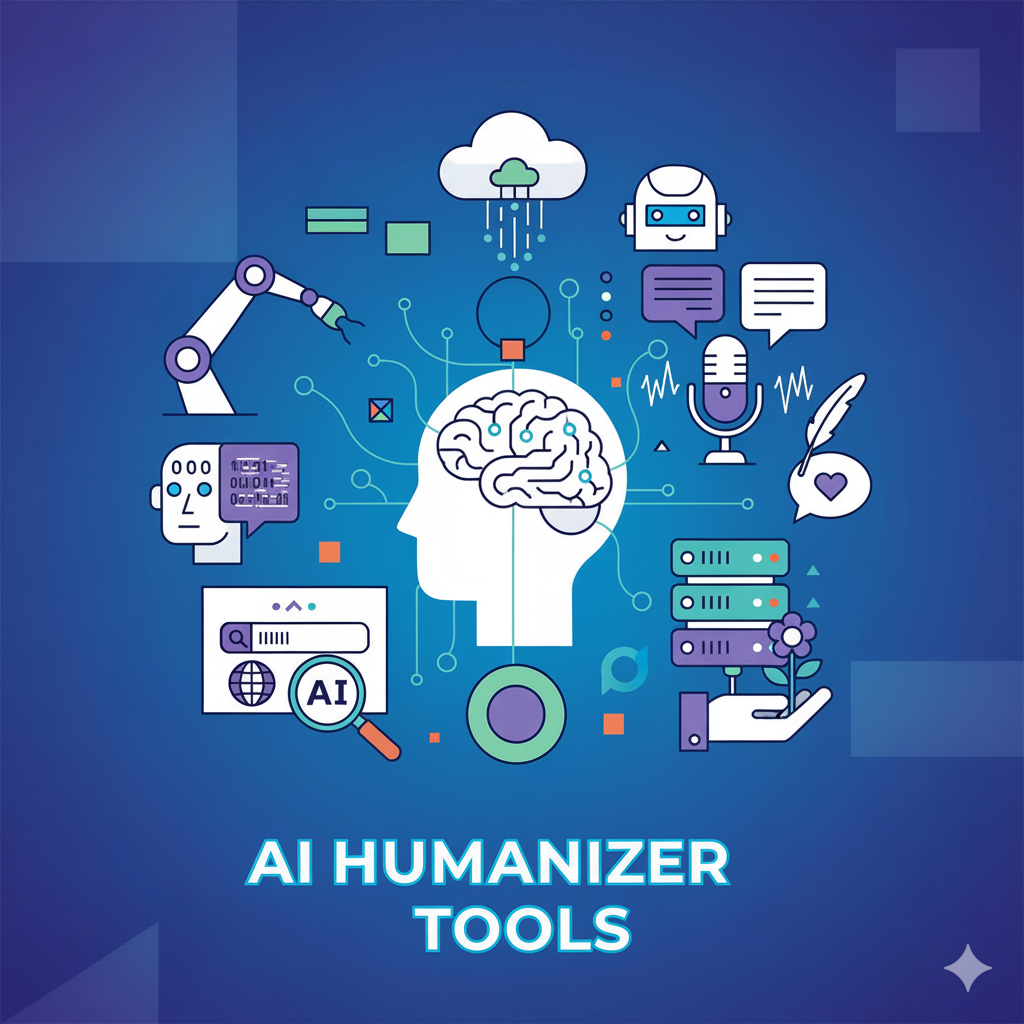AI Humanizer tools are software solutions designed to take text that’s been generated by an AI (like ChatGPT, Claude, GPT-4, etc.) and rewrite or refine it so that it reads more naturally human. They aim to reduce the robotic or formulaic feel of AI writing, improve flow, tone, readability, and in many cases, help content avoid detection by tools that flag AI-written text.
Below, I’ll walk through why these tools are useful, what to look for, some good current options, and how to pick the one that’s “best” for you.
Why People Use AI Humanizer Tools
Here are the main reasons people turn to humanizers:
- Natural tone & readability: AI often produces text that’s grammatically correct but flat, a bit uniform, or predictable. Humanizers break up patterns, add variation, improve sentence flow.
- Pass AI-detection filters: With more institutions, publishers, and platforms using tools like GPTZero, Turnitin, Originality.ai, etc., there’s concern that AI-generated text may be flagged. Humanizers try to help by altering the “signatures” that detectors latch onto.
- Preservation of voice & meaning: When you generate content, often you want it to retain your style, your message, your keywords. Good humanizer tools try to maintain that.
- Saving editing time: Without a humanizer, you may need to manually polish AI outputs. A good tool can handle much of that automatically, leaving you to fine-tune.
What to Look for in a Great AI Humanizer Tool
To decide which tool is “best,” you need evaluation criteria. Here are things you should check:
| Criteria | Why It Matters |
|---|---|
| Quality / Naturalness of Output | If the humanized text still sounds robotic, then the tool hasn’t done the job. You want variation in sentence structure, tone, rhythm. |
| Accuracy / Meaning Preservation | The tool must keep your core message, not distort meaning just to avoid detection. Also should preserve key terms & context. |
| Detector Resistance | If avoiding detection is a goal, test the tool with major detectors. |
| Customization / Control | Ability to adjust tone (formal, casual), intensity of rewriting, style, etc. So you can match the voice you want. |
| Speed / Workflow Efficiency | How fast is the humanization? How easy is the interface? Do you need to copy-paste manually, or can you upload documents? |
| Languages Supported | If you work in multiple languages, you’ll want tools that work beyond just English. |
| Cost / Free Tier | Many tools have free versions or trials. You should check what you get vs. paying. |
| Privacy / Data Security | If your content is sensitive (academic, business), you’ll want that your data isn’t stored or misused. |
| Additional Features | Like built-in AI detector, bulk processing, style/voice preservation, readability metrics, etc. |
Some Popular AI Humanizer Tools & What They Do Well
Here are several tools currently used with good feedback, along with their strengths (and caveats) based on recent info as of 2025:
| Tool | What It Does Well | Things to Check / Limitations |
|---|---|---|
| Walter Writes AI | Very highly rated for producing text that sounds genuinely human. Offers adjustable rewrite strength, built-in AI detector, supports many languages. Many users say it consistently passes major detectors like Turnitin, GPTZero, etc. | Paid plans likely for heavier usage. For very formal or academic content, some tweaking may still be needed. Some users mention cost if processing long documents. |
| HumanizeAI.io | Free options, multiple rewrite modes (basic, aggressive, etc.), large user base. Claimed ability to get very low AI detection scores. | As with many free tools, when content is long or complex, quality might drop or rewriting may get too aggressive. Also “0% detection” claims should be taken with caution—depends on what detector is used. |
| Humanize (Humanize.org) | Simple, fast, no sign-up required. Good for quick pasting & humanizing small texts. | Might not have depth of customization. For large content / detailed rewrite (academic, technical) might require more manual editing. |
| Humanizer.ai | Easy to use; friendly interface; good for improving tone, flow, and readability. | Has word-limits; sometimes output feels “light” if you want heavy rewriting. Also, whether a humanizer “passes” all detection tools isn’t always guaranteed. |
| Ahrefs’ AI Text Humanizer | Part of a well-known SEO tool brand; can help blend humanization with an SEO workflow. Useful for blog posts / marketing content. | Likely more geared toward content marketing rather than strict academic content. Also, may have limits on customization. |
| Smodin’s AI Humanizer | Supports many types of content (essays, social media, etc.); users report it helps “remove robotic tone” and can be good when combined with manual edits. | Some outputs may need tweaking; free version or settings might be limited; for formal/academic style you may need to verify. |
What Are Some Tools That Don’t Always Do Well
It’s also useful to know where humanizer tools often stumble:
- They sometimes over-paraphrase, changing tone or nuance too much. You may lose your “voice.”
- In trying to avoid detection, they might produce awkward or unnatural phrasing.
- For technical or domain-specific content (scientific, legal, academic), jargon, precision, references, and structure matter a lot; humanizers may mess up citations or specialized vocabulary.
- Long form content may require splitting into parts or more manual editing.
How to Test Them Yourself
If you want to pick the best humanizer tool for your own work, here’s a mini workflow you can follow:
- Pick a sample text: Something you’ve generated with AI (blog post, essay, email, etc.).
- Run it through 2-3 humanizer tools: Try different rewriting styles (light vs. heavy).
- Evaluate the output:
- Does it preserve your meaning and important keywords?
- Does it flow naturally (read out loud if needed)?
- Does it sound like you or like someone with very different style?
- Test with AI detection tools if that’s relevant (Turnitin/GPTZero/or others).
- Check editing needed: How much tweaking is needed after humanization to align voice/style/accuracy?
- Compare cost vs benefit: Time saved, quality gained vs money spent.
Which Tool Might Be Best for Different Use Cases
“Best” depends heavily on what kind of content you’re producing, how often, how polished it needs to be, and how much cost/time you can invest. Here’s a guide:
| Use Case | What You Should Prioritize | Likely Best Tool |
|---|---|---|
| Academic / Essays / Research Papers | Strength in meaning preservation, high detection resistance, support for citations, formal style | Walter Writes AI; maybe HumanizeAI.io (with careful checking) |
| Content Marketing / Blogs / SEO | Natural tone, readability, SEO-friendly structure, decent speed | Ahrefs’ humanizer, HumanizeAI.io, Walter Writes AI |
| Social Media & Short Copy | Speed, casual tone, minimal friction | Humanize.org; Smodin; Humanizer.ai |
| Business Communication (Emails, Reports) | Professional tone, subtle humanization (not overdoing the changes), consistency | Walter Writes AI, HumanizeAI.io; maybe premium features of top tools |
My Recommendation: What I’d Pick
If I were you, here’s what I’d probably go with (based on current tools):
- For regular work (blogs, long content, academic): Walter Writes AI is my top pick, because of its consistency, customization, built-in detector, and strong feedback from users.
- For smaller work or when I just need quick fixes (social media, short copy): HumanizeAI.io or Humanize.org.
- If cost is a concern, start with free versions / trials, test with your sample content, see which gives the least editing afterward.
Ethical Notes & Best Practices
Just to round off, there are ethical and practical considerations:
- Always ensure transparency where needed (for instance, in academic settings) about what parts are AI-assisted. Using humanizer tools doesn’t always remove all issues.
- Don’t rely wholly on bypassing detection; use your own style, voice. Tools are aids, not replacements.
- Check plagiarism, citations, factual accuracy. A humanizer won’t fix factual errors.
- Be careful with sensitive content; make sure the tool respects privacy, doesn’t store your content, etc.
Conclusion
There’s no single “best” AI humanizer tool that is perfect for everyone. What matters most is matching the tool’s strengths to your use case, being aware of its limitations, and doing your own testing.
As of now, Walter Writes AI seems to lead in terms of overall capability, especially for content that needs to both sound human and avoid detection. But for lighter or less formal content, tools like HumanizeAI.io, Humanize.org, Smodin etc. can be great, cost-effective choices.
Discover more from PratsDigital
Subscribe to get the latest posts sent to your email.



Pingback: Is It Premier AI Tool for Search Optimization in Marketing? - PratsDigital